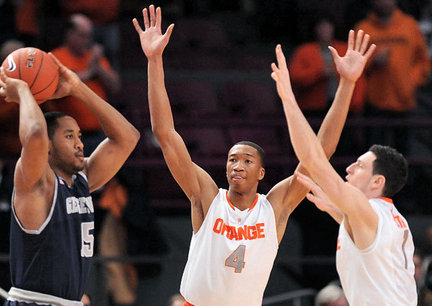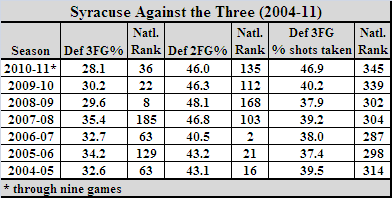Behind the Numbers: The Counterintuitive Result of the Syracuse Zone
Posted by KCarpenter on December 8th, 2010Kellen Carpenter is an RTC contributor.
While theoretically, the intricacies of basketball should provide for a near-infinite array of offensive and defensive strategies, we instead see a surprisingly few varieties of essential approaches. On the defensive end, simple man-to-man defense is the primary defense of the vast majority of college basketball teams. Other types of defense are less common, but the clear runner-up in terms of defensive schemes is 2-3 zone defense, which is usually what TV and radio people mean when they say “zone defense.” More specifically, when radio and television people refer to “the zone” they probably mean the version of it that is run by Jim Boeheim in Syracuse, and with good reason.
It takes only the mildest interest in college basketball to know that Syracuse under Jim Boeheim has been a perennial contender for the national championship. Year in and year out, the young men in orange appear ready to take all comers each and every March. And aside from the constants of Boeheim himself and a steady flow of NBA-caliber talent, the other constant is the zone. Boehim isn’t just an accomplished practitioner of the zone, but a certified guru. His mastery of this defensive system and ability to impart that system to others has made him a coach in demand. When Mike Kryzewski needed a coach to teach the US Olympic team about the zone, Boeheim was the natural choice. The curmudgeonly coach, Syracuse, and the zone have merged into a monolithic juggernaut that seem destined to befuddle under-prepared offenses come tournament time. As such, the question of how to execute zone defense effectively isn’t as interesting to most teams as how to overcome it.
Now, on the topic of attacking a zone, I don’t have the benefit of the advice of smart scouts, assistant coaches, and the strategic gurus who are working hard to win their respective teams’ games. Instead, I get the second-hand advice of guys who are on television and radio, ex-coaches and ex-players, and the most pernicious and dangerous of strategic advisers, basketball writers. These folks tend to repeat, in unison, some familiar refrains. It’s almost inevitable that when I hear or read someone talk about the zone, they mention the same weaknesses: vulnerabilities to perimeter scoring and offenses that run through the high post. It’s what they seem to say almost every single time, and that’s fine. These approaches make sense when you watch the ball move against the zone: the ball is passed into a player at the high post, sucking in defenders from the perimeter or near the goal, and opening up either a three-pointer from the corner or a quick pass to a baseline-cutter making a move to the basket. So, a solid piece of conventional wisdom, right?
Well, maybe not. The mind is a funny thing, prone to remember triumphs more clearly than failures and generally to overestimate probabilities and degrees of success. Fortunately, even if our subjective memory and evaluation of past events isn’t reliable, we always have the box scores to turn to, and to those we shall turn. If the advice of the pundits and analysts is accurate, teams that run the zone defense should expect to have their opponents make three-point shots against them at a pretty good clip.
You know where this is going. Syracuse, the paragon of zone defense, has been defending against the three incredibly well. After last night’s game against Michigan State, Syracuse has held opponents to 28.1% shooting from beyond the arc, good for 36th best in the country according to Ken Pomeroy [ed. note. MSU shot 7-24 from three for 29% last night]. For comparison, they are holding opponents to 46.0% of their two-pointers, which is rather mediocre and ranks as 135th best in the country. Perhaps incredibly and definitely counterintuitively, the famous Syracuse zone defense’s strongest attribute seems to be defending against the three!
This is the part where it would normally be appropriate to point out that it’s early in the season and that perhaps the responsible party is not so much the Syracuse defense as much as a small sample size and flukey numbers. If we look at last season, however, this trend is no fluke. In 2009-10, Syracuse had the 22nd best three-point defense, holding opponents to 30.2%. In 2008-09, the Orange had the 8th best three-point defense, holding opponents to 29.6%. Over the past few years, it’s clear: Jim Boeheim’s team has been great at defending against three-point shots, and that’s a large part of the reason for their success.
By itself, this trend is moderately interesting, but there’s a second part of the story that elevates this trend from notable to outright goofy. The ironic thing is, since teams tend to believe that the zone is vulnerable to three-point shooting, players take a bunch of three-point shots against Syracuse. So far this year, opponents have taken a greater proportion of three-point shots (46.9%) against SU than against any of the other 344 teams in Division I. This isn’t a small sample size issue either: last season, Syracuse had the 8th highest percentage of threes taken against them, and in 2008-09, they were in the top fifty. The obvious conclusion is that Syracuse’s opponents are taking a much higher number of threes against one of the best three-point defenses in the country, a strategy fraught with peril. Why is that?
It seems to be because of that bit of conventional wisdom discussed above — that standard grade-school-on-up advice on how to attack a zone — that teams are tricked into attacking the SU zone in a very inefficient way. The myth of “open shots” seems to be generating poor decisions and actually strengthening the power of the zone. If that is what Boeheim intended… well-played, Syracuse.
One quick note about general extrapolation from the last three years of three-point defense. As you can see above in the table, Syracuse’s exceptional strength defending against the three is a relatively new phenomenon. From the 2004-05 to the 2007-08 seasons, the power of the Syracuse defense was in protecting the rim and it is exhibited above by the numbers. Through strategy, personnel or some combination of both, Jim Boeheim has found a way to introduce a new wrinkle that drastically improves Syracuse’s defense against perimeter shooting while simultaneously encouraging teams to shoot more of them! I think it’s incredible that one of the basic truisms about the zone happens to be patently awful advice against the team that is most famous for its zone defense. It will be interesting to see if anyone figures this out this season — Michigan State certainly fell victim to it last night.












































Great article.
As a Syracuse fan, I’ve taken notice of this as well over the past two years. I think a key factor behind the recent uptick has been the change in personnel, which goes back on the coaching staff for finding ways to make the zone better.
While Johnny Flynn and Eric Devendorf were excellent scorers, they left a lot to be desired on the defensive end. Watching them, you got the impression that they wanted to play man-to-man – and to be honest, they weren’t good fits for zone defense given their size. Since then, the backcourt has turned over with Brandon Triche, Andy Rautins (since graduated) and Scoop Jardine much more willing and better suited physically to disrupt the perimeter game.
The answer now seems not to get the ball in the high post or jack threes, but to work the ball around and wear down the zone to the point where it opens up lanes and good shots.
The one question I would have is, why havent the Orange and this great zone had more post season success? They seem to be constantly losing to lower seeded teams in March and rarely get past the round of 16 (4 times in all of Boeheims career).
Why is this?
I remember watching a Syracuse game last season. The opponent (can’t remember who) hit a couple of early threes, and Jay Bilas said something like “that’s the worst thing that could happen to them, I bet Jim Boeheim actually likes that they made them,” because hitting a couple early will only induce them to take more and more, and Boeheim’s long defenders have turned them into especially low percentage shots. I also remember Bobby Knight raving over last year’s edition, claiming it was one of the best defensive teams – man or zone -that he had ever seen.
orangeguy is on target as far as shift in guard personnel. The guards are six/four to six/five now. Same for the guys coming in next season. With their length they push the line out without actually having to move out that much themselves. And they’re quick enough to make the shifts. Watched the MSU game from an amazing courtside seat, up close and personnel. The aggressiveness of the zone was overwhelming, leaving MSU really confused as to where to go. Just kept trying to find a way to break the wall of bodies and arms and almost never could. I could see the shut em down expressions on the faces of the SU defenders as they pressured the ball, loving the traps in the corners. I could hear them communicating, keeping each other aware of any possible opening in their shield. I was so impressed and so happy they were my team and not the opposition. I was next to MSU fans. They were just damned frustrated as they watched their guys passing the ball round and round the circle, unable to find a crack.
I agree that the length of the zone, particularly up top, could be what makes the Syracuse zone so efficient against the three. The one thing that Syracuse’s zone seems to do well is push opposing offenses further away from the basket when running their sets. Since I live in Syracuse and get to see virtually every game they play, I have noticed that the top of the zone can be so long and active that opposing teams are taking their three point attempts from deeper than they would normally. I would imagine that the further behind the three point line the shooter is, the lower their percentage becomes. This, when combined with the conventional wisdom that you attack the zone by exploiting the three shot, leads to a lot of low percentage three point attempts.
I guess that the moral of the story is that the 2-3 zone needs to be re-thought from both an offensive and defensive standpoint. This article touches on the offensive side of things, but what Syracuse’s success has also shown is that the 2-3 zone may not be best suited to unathletic team that needs to slow the game down. Rather, the 2-3 is best utilized by long, athletic teams that can defend a lot of court and recover quickly. Moreover, since everyone is keyed in on the ball, when there is a turnover, everyone can run out of it and get into transition quickly. Perhaps more uber-athletic teams should use the zone. If my memory serves, it worked pretty well for UNLV in the early 90s with Augmon, et al., as well.